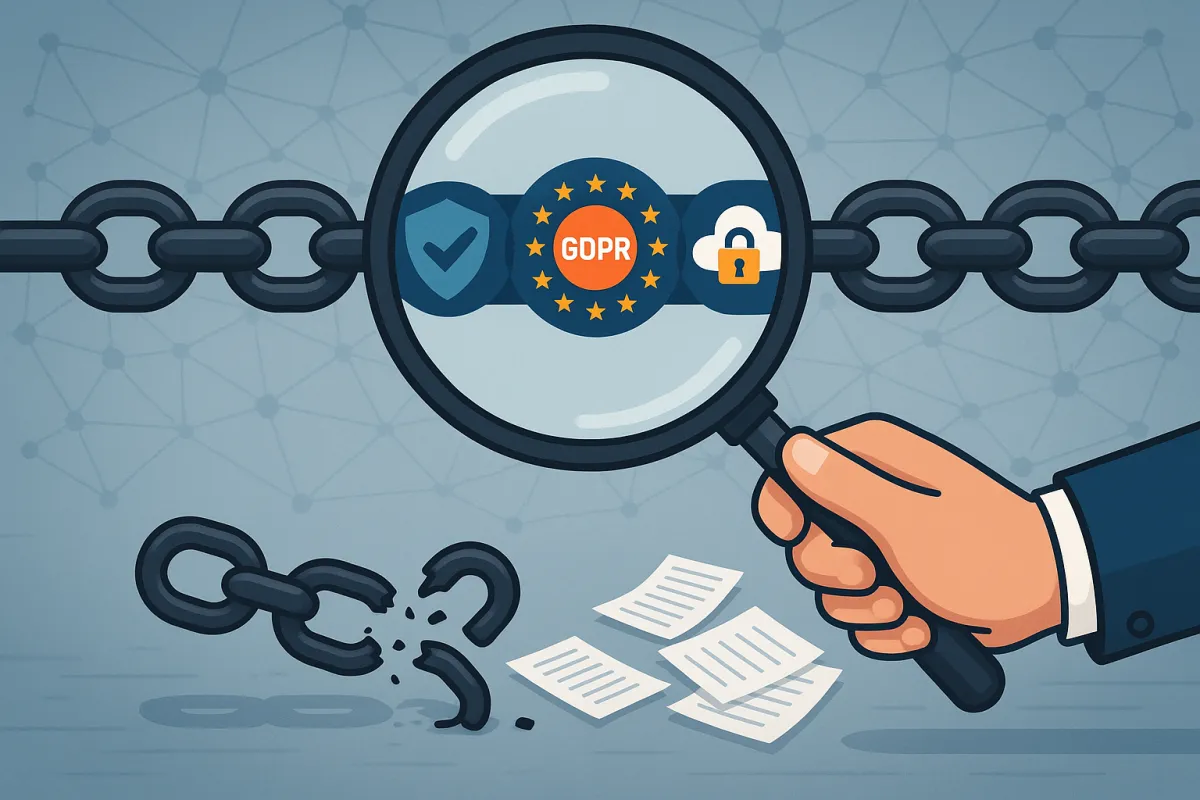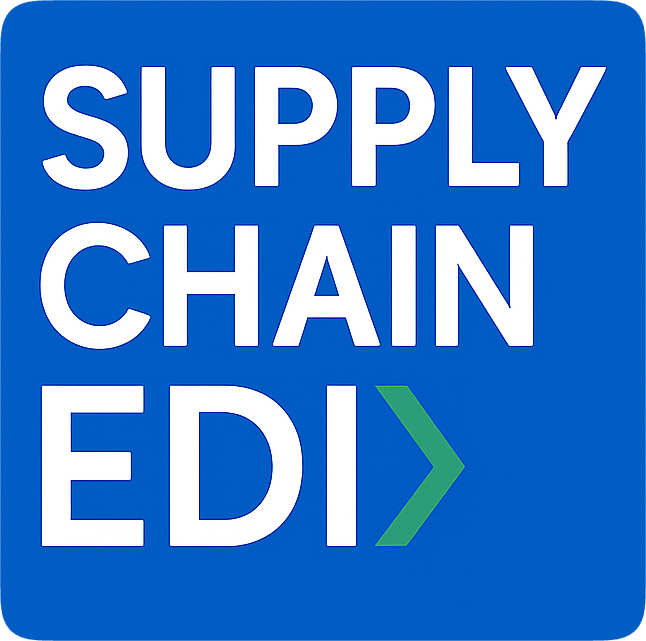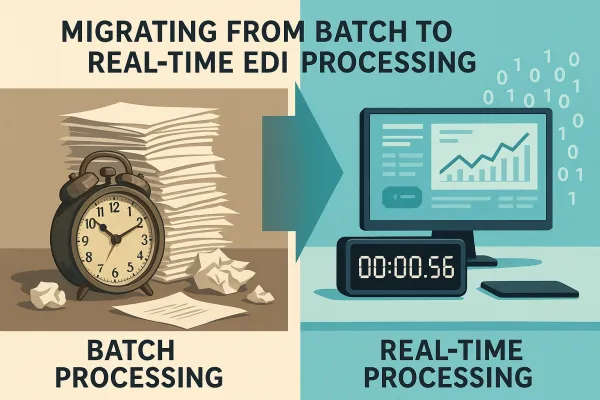The Complete EDI Vendor Security Audit Checklist for 2025: Ensuring GDPR Compliance and Data Protection in Your Supply Chain

When supply chain attacks surged 26% from 2022 to 2023, and doubled again in 2025, your EDI vendor security audit suddenly became less optional and more survival. The Change Healthcare breach that compromised 100 million records shows exactly what happens when third-party security fails. Your suppliers, logistics providers, and EDI vendors handle your most sensitive business data daily. One weak link can cascade across your entire network.
This EDI vendor security audit checklist addresses the specific vulnerabilities that matter most in supply chain data exchange. You'll find practical assessment criteria that go beyond generic vendor questionnaires, focusing on the technical requirements and compliance standards that protect EDI transmissions. Whether you're evaluating new providers like Cargoson, IBM Sterling, or TrueCommerce, or auditing existing relationships, these criteria help identify real security gaps before they become breaches.
Regulatory Compliance Requirements for EDI Vendors
GDPR compliance isn't optional for EDI providers serving European markets. Article 28 requires data processors to implement appropriate technical and organisational measures to protect personal data, making your EDI vendor legally responsible for meeting these standards. While most EDI transactions involve business data rather than personal information, any processing of employee names, contact details, or customer identifiers triggers GDPR requirements.
Your audit should verify that EDI vendors maintain written data processing agreements (DPAs) with proper controller authorization before engaging sub-processors. Check if they've appointed Data Protection Officers where required and maintain processing records as mandated by GDPR accountability requirements. The regulation's €20 million or 4% global revenue penalty structure makes vendor non-compliance your financial risk too.
Healthcare EDI requires HIPAA compliance for any transactions containing protected health information. PCI DSS applies when processing payment card data through EDI channels. Don't assume your EDI provider handles multiple compliance frameworks equally well. MercuryGate and Descartes often maintain separate compliance certifications for different industry verticals, while platforms like Transporeon focus heavily on automotive and manufacturing standards.
Network Security and Infrastructure Assessment
Penetration testing reveals what vulnerability scans miss. Your EDI vendor should conduct regular penetration tests by certified third parties, not just internal security assessments. Ask for recent test results and remediation timelines. When over 87,000 Fortinet devices were exploited through critical vulnerabilities in 2024, it highlighted how quickly infrastructure weaknesses spread across customer networks.
AS2 and SFTP protocols provide baseline security, but implementation matters more than protocol choice. Verify that vendors use current TLS versions (1.2 minimum, preferably 1.3) and strong cipher suites. IBM Sterling typically excels at protocol security, while newer providers sometimes lag in encryption standard adoption. Check certificate management practices and key rotation schedules.
Infrastructure redundancy goes beyond simple backup systems. Evaluate geographic distribution of data centers, network path diversity, and failover testing frequency. Cleo and SPS Commerce maintain multiple data centers with active-active configurations, while smaller providers might rely on single-point-of-failure architectures. Your audit should include specific SLA requirements for recovery time objectives (RTO) and recovery point objectives (RPO).
Data Handling and Encryption Standards
Data encryption requirements differ dramatically between data at rest and data in transit. Your EDI vendor should implement AES-256 encryption for stored data and Perfect Forward Secrecy for transmission protocols. AS2 protocols with SSL/TLS encryption ensure only authorized parties access transmitted information, but verify that vendors haven't implemented weak configurations that compromise these protections.
Key management practices often reveal security maturity levels. Assess how vendors generate, store, rotate, and revoke encryption keys. Hardware Security Modules (HSMs) provide stronger key protection than software-only solutions. E2open/BluJay and Alpega typically implement enterprise-grade key management, while smaller providers might use less robust approaches.
Data retention and deletion policies require specific audit attention. GDPR Article 28 mandates that processors delete or return personal data upon service termination. Verify that EDI vendors can demonstrate secure data destruction and provide deletion certificates. Many providers archive transaction data indefinitely for debugging purposes without considering regulatory implications.
Access Controls and Identity Management
Role-based access control (RBAC) implementation varies significantly across EDI providers. Evaluate how vendors segregate administrative access, user permissions, and system-level privileges. Your audit should verify that employees can only access data necessary for their specific job functions. Multi-factor authentication should be mandatory for all administrative accounts, not optional.
Integration with enterprise identity management systems often determines how well EDI security scales with your organization. Oracle TM and SAP TM implementations typically support SAML 2.0 and OAuth 2.0 for single sign-on, while legacy EDI providers might require separate credential management. This creates additional security overhead and increases breach risks.
Privileged access monitoring becomes critical when EDI vendors need emergency access to resolve transmission issues. Verify that vendors log all privileged actions, implement break-glass procedures with proper approvals, and conduct regular access reviews. Session recording and real-time monitoring help detect unauthorized activities before they escalate.
Audit Trails and Monitoring Capabilities
Comprehensive logging goes far beyond basic transaction records. Your EDI vendor should capture user authentication events, configuration changes, data access patterns, and system administration activities. GDPR compliance requires processors to make available all information necessary to demonstrate compliance, making detailed audit trails legally mandatory.
Real-time monitoring capabilities help identify security incidents as they develop rather than after damage occurs. Evaluate whether vendors implement behavioral analytics to detect unusual access patterns or data transmission anomalies. 3Gtms/Pacejet and Blue Yonder typically provide advanced monitoring dashboards, while traditional EDI providers might offer limited visibility.
Log retention and analysis capabilities determine how effectively you can investigate security incidents. Verify that vendors maintain tamper-proof logs with appropriate retention periods for your industry. Integration with SIEM platforms enables centralized security monitoring across your entire supply chain infrastructure, including EDI data flows.
Business Continuity and Disaster Recovery
Recovery time objectives should align with your business requirements, not vendor convenience. Assess whether EDI providers can restore services within your required timeframes during various failure scenarios. Geographic redundancy helps protect against regional disasters, but implementation quality varies significantly between providers.
Backup procedures require technical verification beyond vendor assurances. Review backup frequencies, restoration testing schedules, and data integrity verification processes. FreightPOP and Manhattan Active typically implement automated backup testing, while smaller providers might rely on manual processes that introduce human error risks.
Communication procedures during outages often receive insufficient audit attention until problems occur. Verify that vendors maintain updated contact lists, implement automated incident notifications, and provide regular status updates during service disruptions. Multi-carrier shipping platforms like ShipStation/ShipEngine usually excel at incident communication due to their real-time operational requirements.
Vendor Assessment Documentation and Scoring
A structured scoring framework prevents subjective evaluation and ensures consistent vendor comparisons. Weight different security categories based on your specific risk profile and regulatory requirements. Infrastructure security might receive higher scores for manufacturers with complex supply chains, while data handling practices could be more critical for healthcare organizations.
Documentation requirements should include security certifications (SOC 2 Type II, ISO 27001), compliance attestations, and third-party audit reports. Vendors reluctant to provide detailed security documentation often lack mature security programs. Request specific evidence rather than accepting generic compliance statements.
Integration with broader vendor management processes helps maintain consistent security standards across all suppliers. Consider how EDI vendor security assessments align with your existing vendor risk management framework. Platforms like Cargoson that provide comprehensive carrier integrations should undergo the same rigorous security evaluation as traditional EDI providers.
Regular re-assessment schedules ensure security standards remain current as threats evolve. Annual assessments provide baseline coverage, but quarterly reviews might be necessary for high-risk environments. Supply chain attacks doubling in frequency since April 2025 suggests that static annual audits no longer provide adequate protection.
Your EDI vendor security audit checklist should evolve with emerging threats and regulatory changes. Focus on technical implementation details rather than policy statements, verify claims through evidence review, and maintain regular assessment schedules that match your risk tolerance. The vendors managing your supply chain data today will largely determine whether your organization appears in tomorrow's breach headlines.





